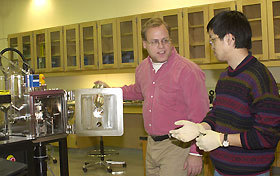For more archives, go to the Advance Archive/Search Page.
Condensed Matter Physicist Studies
Behavior Of Superconductors
Barrett Wells has a favorite experiment that he performs right at his desk for visitors. He takes a piece of superconductive material about the size of two quarters stacked together, places it in a Styrofoam dish, pours liquid nitrogen on it to chill it, and then, with tweezers, places a tiny, 1/8-inch square magnet above it. The magnet levitates, spinning in the air just above the superconductor, which will repel any pole the little magnet presents.

|
|
Barrett Wells, assistant professor of physics, works with Feizhou He, a physics graduate student, using the Pulsed Laser Deposition
machine, equipment for studying and analyzing the activity of superconductors.
Photo by Melissa Arbo
|
"It looks like magic," says Wells, an assistant professor of physics. "I want to know why that works."
It's a small, dramatic demonstration of what high-temperature superconductors can do. Trains powered by superconductors using magnetic levitation have been built and one day may be commercially viable. Superconductors already create the electric fields used in magnetic resonance medical imaging. They are also expected to play a role in future power generation and transmission and in super-speedy supercomputers, among other things.
Wells, a condensed matter physicist - a scientist who studies the basic properties of materials - is interested in high-temperature superconductors because of the puzzles they present to physicists. They don't conform to established physics theories of how materials should behave.
Although they are termed "high-temperature," in fact the superconductor s are extremely cold, about 150 degrees above absolute zero temperature, the temperature at which molecules cease to move.
Put a current through a loop of superconductive wire and, without a battery, the current will continue as long as the wire is in its super-conductive state.
"It sounds like a perpetual motion machine," Wells says. "It's probably as close as you can come to that."
The absence of resistance to electric current, and the characteristic of repelling any magnetic field, make high-temperature superconductors amazing materials. At their extremely low temperature, these materials shouldn't conduct electricity at all, Wells says. His job is to try to understand why they do.
The key issue is how the electrons in superconductors hop from atom to atom, Wells says, and how that might be controlled. To study the activity of superconductors, Wells grows thin films - only a few nanometers thick - of complex oxides on top of a crystal substrate, in order to study the properties of the oxides. The crystal substrate is used because the films are too thin to pick up by themselves, and the atoms in the crystal form a regular pattern.
The atoms of the oxide film want to line up with those of the substrate, but they might be bigger or smaller, with more or less space in between. By squeezing or stretching them, Wells can make it easier or harder for the electrons to hop. Using a synchrotron - a powerful light source - at Brookhaven National Laboratory, where he was a guest researcher before coming to UConn and still does some of his research, Wells measures how x-rays scatter off the films, so that he can determine the spacing of the atoms.
His job is to develop techniques to make the films and study them and to come up with reliable information about their properties. He and S. Pamir Alpay, an assistant professor of metallurgy and materials engineering, share grant funding from the State of Connecticut to build an ultra-modern Pulsed Laser Deposition chamber that is now nearing completion in the new Biology/Physics Building. There they grow and analyze the films, using the type of laser that is used in eye surgery, only larger.
Wells is in the first year of a five-year, $450,000 National Science Foundation (NSF) Career Award to study the materials and to develop student mentoring processes to improve the retention of physics majors.
He was in college when high-temperature superconductors were discovered in the 1980's, and it was the 'wow' factor surrounding them that kept him interested in physics. "I certainly started college not knowing what I was going to do," he says.
A native of Winnipeg, Canada, he was always good at science, however, and his father was a physicist. At first, reading about space spurred his interest in physics.
He had finished his undergraduate degree at Stanford University and was thinking of returning there for graduate work in physics, after a brief stint at Cornell in engineering, when "the Woodstock of physics" happened, as he described it - a national meeting of physicists in 1987 where discussion about superconductors really heated up. The discussion was triggered by the discovery a year earlier that ceramics, normally insulators, could function as very high-temperature superconductors. The two IBM researchers who discovered this won the Nobel Prize in 1987; their work led other scientists to look for higher and higher temperature superconductors.
What generated the intense interest, and what still fascinates Wells, is that the problems presented by superconductors are "at the boundaries of physics," he says. They are at the center of a class of problems being studied by condensed matter physicists today, and they are of interest to a growing group of scientists - in engineering and in physics - at UConn.
The work on films produced in the Pulsed Laser Deposition chamber will be an important new research tool at UConn "that will serve as a seed," as Wells describes it, fostering further research in this cutting-edge area.
Scientists don't yet know why a particular material is a superconductor at certain temperatures. They can't describe this mathematically or predict its behavior, Wells says.
But if that question can be answered, it could open up whole new avenues of research, he says: "We know it's tied to some of the big things we don't understand in physics."

